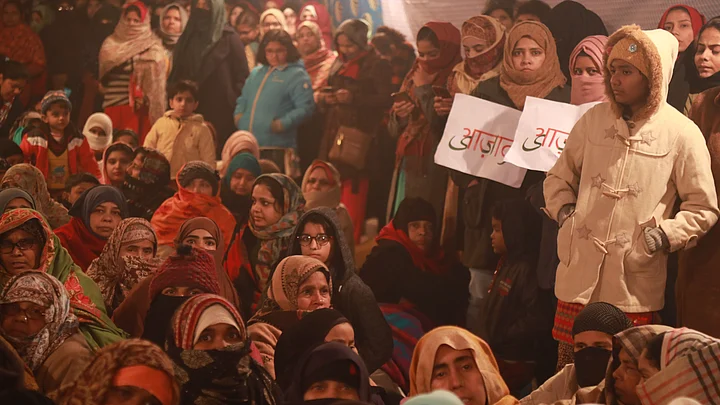For over a month now, India has been witnessing widespread and sustained protests over the ruling central government’s polarising Citizenship Amendment Act (CAA). University campuses across the country have also been sustaining these protests. Jawaharlal Nehru University (JNU), which has been a major site of protest, has found support from one of the most (traditionally) ‘silent’ groups of this country: Bollywood A-Listers like Deepika Padukone and Alia Bhatt. Jamia Millia Islamia has given us the enduring image of women in hijabs — Ladeeda Sakhaloon, Ayesha Renna —who stood on top of cars and faced police batons, putting themselves on the line to save male allies.
How Women Are Reclaiming the Streets
Yet, what is perhaps the most significant achievement of this movement is not the visibility of the already ‘visible’, but the emergence of the so-called ‘invisible’. It is clearly this assertive emergence of the underbelly that is the most uncomfortable for those in power: the tiny by-lanes of Chandi Chowk, where after the Friday prayers, Bhim Army chief Chandrashekhar Azad emerged holding the Indian Constitution; Mumbai, Kochi and Hyderabad which traditionally haven’t been as vocal but have risen to protest this time — and how — and of course, hordes of women, such as those in Delhi’s Shaheen Bagh, who have been sitting on dharna for about a month.
The Muslim women of Shaheen Bagh, and now, Park Circus area in Kolkata have been sitting every single day in peaceful protest along with their children, and offering food and drink to all those who are coming to offer solidarity.
These women have made the streets their home and have changed the very language of rebellion.
Muslim Women have Autonomy; They Don’t Need to be ‘Saved’
As they cook meals and look after their kids, these women chant slogans of ‘Azaadi’; they do not want to shun their roles as wives and mothers, but they have more pressing problems at hand: that of their very identity and existence.
It is perhaps the most ironical turn of events since the Modi government began its ‘anti-Muslim’ offensive by attempting to ‘save’ these women. In the last term, this government tabled the Muslim Women (Protection of Rights on Marriage) Bill 2018 criminalising triple talaq, a practice of divorce under Sharia law that is seen as being biased against women — and that won them the favour of some Muslim women who voted them back to power in 2019. While this seemed to end a long struggle for equal rights, it also infringed on the constitutional right (under Article 25 and 26) of freedom to practice religion.
Breaking Stereotypes About Muslim Women
The women of Shaheen Bagh and Park Circus have turned the tables again. While the Modi government had attempted to bring out a matter of ‘domestic’ and ‘personal’ law to publicly vilify the community, these women have actually brought the ‘domestic’ out onto the streets.
The stereotype of the ‘faceless’, ‘voiceless’, ‘veiled’, ‘submissive’ Muslim woman has finally been shattered.
The collective imagination of the zenana, an inner sanctum within the house for women, to which the Muslim woman has heretofore been relegated, has come out in the open, onto the streets of Delhi and Kolkata, and many other cities. Not only has private domesticity become a part of public imagination, these women have reclaimed what was imagined to be their oppression, and turned it into their resistance.
Can the Subaltern Speak? YES!
Gayatri Spivak, renowned postcolonial scholar and feminist had answered her now iconic question ‘Can the subaltern speak?’ in her essay about similarly ‘saved’ women, with a ‘no’.
But the women of Shaheen Bagh and Park Circus have proved that they can — they are not voiceless. Protests are no longer led by male Hindu students ‘enlightened’ by university education; protests do not need Bollywood heroines to lend them their names, although there is no underplaying the courage that Deepika and Alia have shown. Protests are now led by homemakers speaking in a language that may seem inarticulate, caring for children and feeding strangers and possessing the strongest spines in the country.
These women have shown that the Muslim woman is not a passive entity, that her gender and her religious identity cannot be played against one another, and most importantly, to answer Spivak’s question: she CAN speak!
They have shown that the begumati zuban and the zenana are as political and as public as they are private and domestic. They have broken stereotypes, set headfirst into uncharted territory, and gifted this nation its first public imagination of politically powerful Muslim women since Razia Sultana.
(Srimati Ghosal is an MPhil student of Modern South Asian Studies at the University of Cambridge. She is also a UNESCO Sahapedia Fellow (2019-20). This is a personal blog and the views expressed are the author’s own. The Quint neither endorses nor is responsible for them.)
